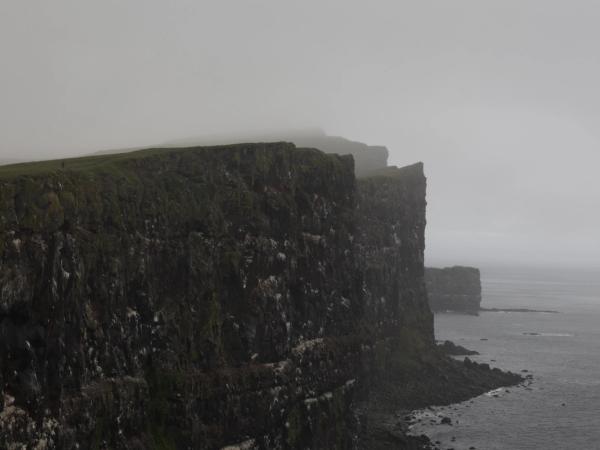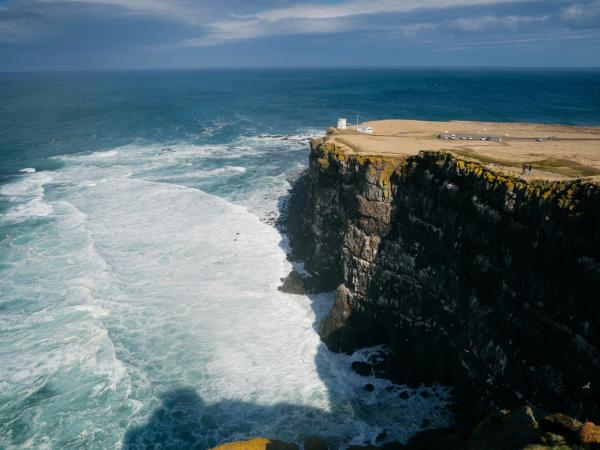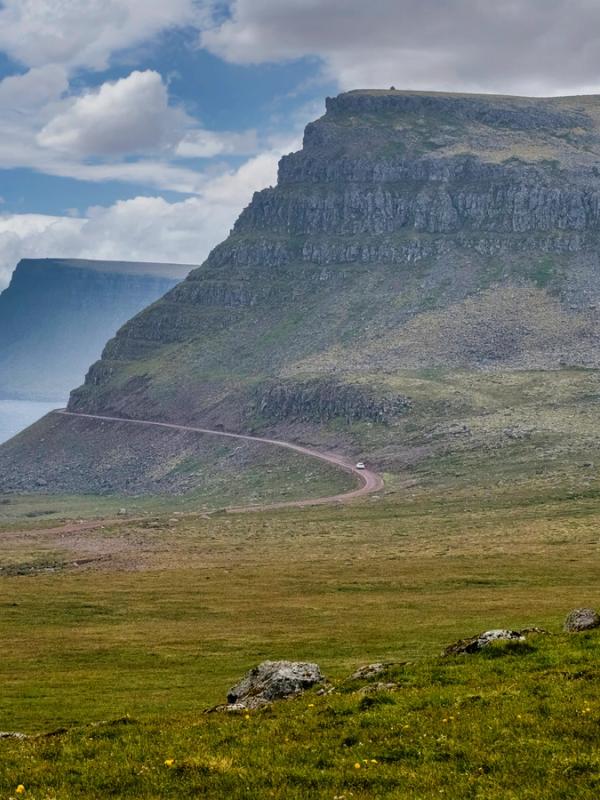
Welcome to Látrabjarg, the edge of the world
Imagine standing on top of a massive cliff, with just the immensity of the sea in front of you. The sense of isolation, surrounded by breathtaking natural beauty, would be absolute if it was not for the thousands of seabirds that cry and fly around you.
In a far corner of the already isolated region of the Westfjords, in northwestern Iceland, it’s Látrabjarg, a place where nature’s drama unfolds in front of you. This place is as wild and raw as it gets, and it's also one of the best places in the country to see birds, such as the puffin.
Join us as we explore this remote part of Iceland, which feels like the end of the world.
Key Takeaways
- Látrabjarg is a series of cliffs located in the region of the Westfjords.
- It’s Iceland’s and Europe’s westernmost point.
- It’s one a prime bird watching spot, with one the largest puffin colonies in the country.
What’s Látrabjarg?
Látrabjarg is a breathtaking promontory on top of a large sea cliff in the region of the Westfjords, in northwestern Iceland. It’s considered to be the country’s and Europe’s westernmost point, if you set aside the Azores, although the Portuguese archipelago is technically on more than one continent.
This cliff stretches for 14 kilometers (8.7 miles) and reaches up to 441 meters (1,447 feet) at the highest point. It’s a geological marvel and one of the world’s premier bird-watching destinations. In fact, it’s Europe’s largest bird cliff. Its vertical faces have been carved by the wind and the relentless waves of the Atlantic Ocean. This area is particularly vulnerable to storms coming from the sea. There’s a lighthouse at the top that helps guide maritime traffic in this part of the ocean.
The cliffs are divided into four sections—Keflavíkurbjarg, Látrabjarg, Bæjarbjarg, and Breiðavíkurbjarg—each offering sweeping views of the ocean and the distant horizon, where Greenland lies just 300 kilometers (186 miles) away.
Geologically, Látrabjarg is part of the Westfjords, Iceland’s oldest region, formed millions of years ago and shaped by glacial and marine forces. The cliffs have layers of basalt and tuff, which indicates a story of volcanic activity and erosion. Some parts have grassy patches, which is where the birds, especially puffins, tend to place their nests. There are several bird species that live or migrate in this area. Here, we can find razorbills, guillemots, fulmars, and kittiwakes, and seals can sometimes be seen on the rocks below.
There’s a historic event that took place in Látrabjarg in 1947. A British trawler named Dhoon was stranded here due to a strong storm. Local farmers and fishermen organized a rescue mission, successfully saving the 12 sailors. There’s a memorial plaque to remember their feat.
Beyond its natural beauty, the sense of solitude that one gets at Látrabjarg is difficult to find anywhere else. There are no fences or rails near the edge of the cliffs, which keeps the landscape as natural as possible, but demands a lot of caution. There are trails at the top, with the vast Atlantic in front of you, but you’ve got to be careful, especially when wet. Whether you come for the views or the birds, Látrabjarg is the kind of place that lingers in your memory.
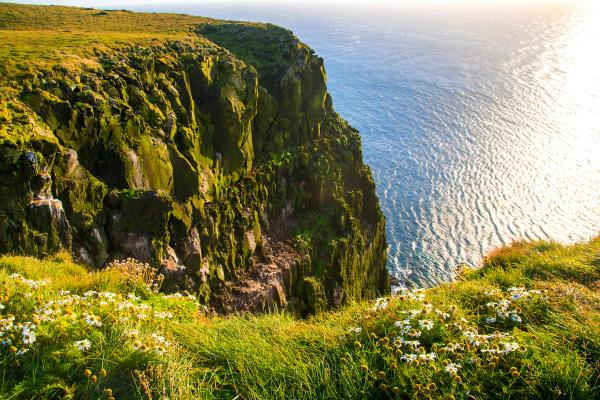
Why is Látrabjarg Worth a Visit?
Látrabjarg combines different elements that create a unique ecosystem. It’s a mix of natural wonder, wildlife, and remote beauty. Here’s why it deserves to be on your itinerary through Iceland.
- Europe’s Westernmost Point: Standing at the Bjargtangar lighthouse, you’re at the literal edge of Europe. That’s a geographical milestone that comes with a feeling that's difficult to explain, but you’ll want to experience it and then share it with your friends.
- Astonishing Wildlife: Millions of seabirds have made Látrabjarg their home, including about one million puffins from May to August. These charismatic birds, with their colorful beaks and funny way of walking, come here to nest. They don’t get startled by humans but it’s important to keep a respectful distance. But that’s not the only species here. It’s estimated that over 40% of the world’s razorbills population also choose this area to breed and nest. On top of that, you’ll see guillemots, fulmars, and kittiwakes, making it a bird lover's paradise.
- Geological Wonder: The passage of time is evident on the walls of the Látrabjarg cliffs. Different layers are evidence of how these cliffs were formed, with basalt and tuff as the primary materials. They show how Iceland was formed, among many other elements, by volcanoes, and how lava got to the sea. Then, the wind, waves, and storms did the rest, sculpting this masterpiece.
- Photography: This place looks like an outdoor studio waiting to be captured. The setting by itself is outstanding, but gets even better with the birds darting across the sky. The light at sunset is especially unique, with the sun going down over the horizon in front of the cliffs.
- A Bit of History: The 1947 Dhoon rescue adds a different layer to this already impressive site. It also shows how the Westfjords locals gave their best to help foreign sailors in need.
- Untouched Wilderness: The remote location and lack of commercial development in the area have preserved Látrabjarg’s raw and unspoiled nature. It creates the feeling of being alone at the edge of the world.
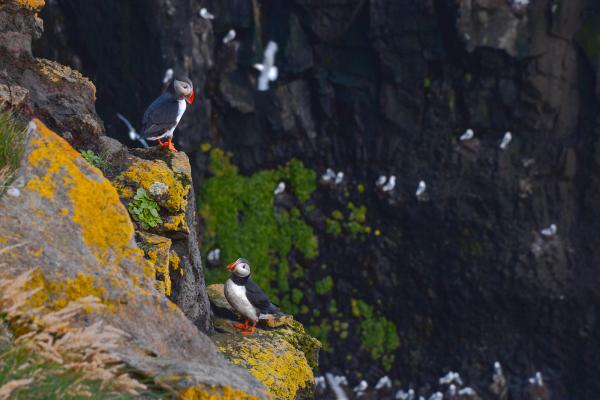
Where’s Látrabjarg and How to Get There
As we mentioned earlier, Látrabjarg makes you feel far away from everything because, in fact, it’s far away from almost everywhere. It’s a remote corner in the Westfjords, the most isolated region in Iceland. This region has a rugged terrain and sparse population, and can be difficult to drive up here depending on the conditions. Getting here from Reykjavik on a day trip doesn’t make much sense, but it should definitely be a stop in an itinerary through this remote but fantastic region.
There’s no better way to travel to Látrabjarg, and to move around Iceland in general, than renting a car. This way you’ll have freedom of movement and you can go wherever you want at your own pace. The cliffs are 418 kilometers (260 miles) from the capital and it usually takes between 6 and 7 hours to get here without stops.
If you’re traveling from there, follow these guidelines:
- Start by taking the Ring Road (Route 1) north from Reykjavik
- Then, turn left onto Route 60 after Bifröst. That’s the road that leads towards the Westfjords.
- Continue on it for another 200 kilometers (124 miles) until you reach Flókalundur.
- There, switch to Route 62, which leads to Patreksfjörður.
- From there, take Route 612, a gravel road, for about 45 kilometers (28 miles) to reach the cliffs’ parking area.
Route 612 is bumpy and potholed, so drive slowly and consider a vehicle with higher ground clearance, like a small 4x4, though a sturdy 2WD can manage in summer. Fill up the deposit in Patreksfjörður, as there are no gas stations near Látrabjarg.
There’s a parking area at Látrabjarg, just at the top of the cliff, near the Bjargtangar lighthouse. It’s free and spacious enough for cars and small vans, but there are no facilities like restrooms or food vendors. Then, there are a couple of minutes on foot to the cliff edges.
It’s important to know that going to Látrabjarg in winter can be difficult or even impossible. Well, traveling to the Westfjords in general. This area is easily accessible between May and October, but the rest of the year, most roads are closed due to heavy snowfall. This is especially true for secondary and gravel roads.
It’s highly recommended to rent a 4x4 vehicle to go to the Westfjords and deal with the uneven roads there, even in summer. It’s important to check the country’s road status before hitting the road.
The Weather at Látrabjarg
The weather in Iceland is not easy to understand. It is wild, unpredictable, and changes constantly. Látrabjarg’s location adds an extra layer of hectic patterns. Here’s what you can expect each season.
Spring (April and May)
Spring arrives in Látrabjarg with temperatures on the rise after winter, ranging from 0°C to 7°C (32°F to 45°F), but it’s often wet and windy. Rain showers are frequent, and fog can cover the cliffs, limiting visibility. The puffins start arriving in mid-May, making late spring a good time for early birdwatching with fewer crowds. The roads may still be snowy or muddy, so check conditions before traveling.
Summer (June to August)
In terms of weather, this is the best time to visit Látrabjarg. The average temperature moves between 8°C and 14°C (46°F to 57°F). The days are really long, with almost 24 hours of natural light by the end of June. The weather is relatively stable, but sudden rain or fog is common. As the cliffs are quite exposed, it’s usually windy, and the air may feel colder than it actually is. It’s the best time for birdwatching. This is the busiest season, but “busy” at Látrabjarg still feels quiet compared to other areas of the country.
Autumn (September and October)
Similar to spring, but moving in the opposite direction. The temperature typically ranges from 2°C to 8°C (36°F to 46°F), accompanied by stronger winds and more frequent storms. Many migratory birds depart by late August or early September, but the cliffs are very photogenic under this season’s light. Route 612, the gravel one leading to the cliffs, can become muddy. The first days of snow can arrive by late October, so driving can get more complicated.
Winter (November to March)
Winter is harsh, with temperatures from -5°C to 3°C (23°F to 37°F). The heavy snow forces the closure of several roads in the region, making it impossible to reach Látrabjarg at times. The conditions at the cliffs are not great, and there’s almost no bird activity.
What to Wear at Látrabjarg
As the weather is so peculiar in the Westfjords, it’s essential to dress appropriately to go to Látrabjarg. Here’s a list of items you should consider bringing:
- Waterproof Jacket: Essential to deal with the rain and wind. If you’re coming in the colder months, consider a waterproof coat.
- Dress in Layers: The best way to deal with the temperature shifts and variable conditions is to dress in layers, even in summer. A thermal base layer, fleece or wool as an intermediate layer; and the aforementioned waterproof outer layer.
- Waterproof Pants: Not completely necessary but can come in handy for sudden showers.
- Hiking Boots: Waterproof, with ankle support and a good grip for walking on wet, uneven trails.
- Hat and Gloves: The wind can bite also in summer, so bring them. Maybe you won’t need them, but they don’t take up much space in your bag.
- Sunglasses: Although Látrabjarg can be cloudy or foggy, the UV rays are intense there in summer.
- Backpack: Carry water, snacks, and extra layers in a small, comfortable pack.
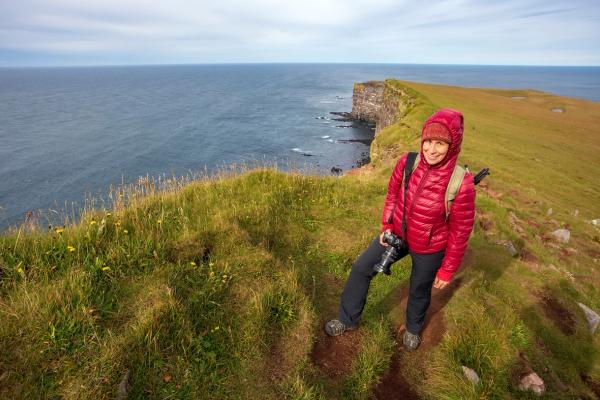
What to See and Do Near Látrabjarg
Going to Látrabjarg is an adventure that you won’t regret. However, as traveling to the Westfjords takes time and effort, you should make the most of your trip. Here you have several attractions in the region that will make the experience even better.
Rauðisandur Beach
Just south of Látrabjarg, this 10-kilometer (6-mile) beach has red, orange, and gold sands, something rare in Iceland. Seals are often spotted here, and there are also chances to see whales, although that is less common.
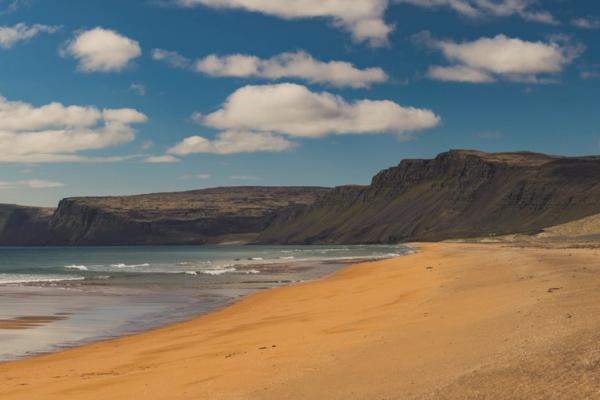
Hornstrandir Nature Reserve
In the northernmost corner of the Westfjords lies Hornstrandir Nature Reserve, one of the most untouched parts of Iceland. There are no roads leading to the reserve, and the only way to go there is by taking a ferry from Ísafjörður, the capital of the region.
Hornstrandir has an extensive network of trails that go through tundra landscapes, cliffs, and over 260 flowering plant species. In this area, the Arctic fox roams freely and it’s relatively easy to see this animal. You can go on a day trip or take a few days, as there are camping areas in the reserve. Having said that, you need to be self-sufficient while there, as services are very limited. It’s only possible to go during the summer.
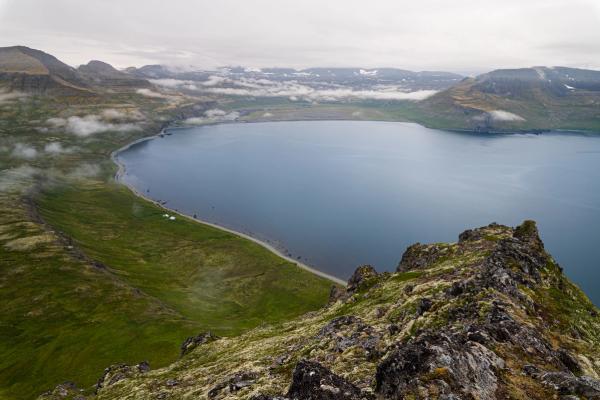
Flatey Island
Flatey is an island in the middle of Breiðafjörður Bay, which separates the Westfjords and the Snæfellsnes Peninsula. It’s only accessible by ferry, and cars are not allowed on the island. Back in the day, it was a busy fishing hub, but nowadays it’s a quiet place with colorful wooden houses and a rich birdlife. It has a beautiful church and the oldest library in Iceland.
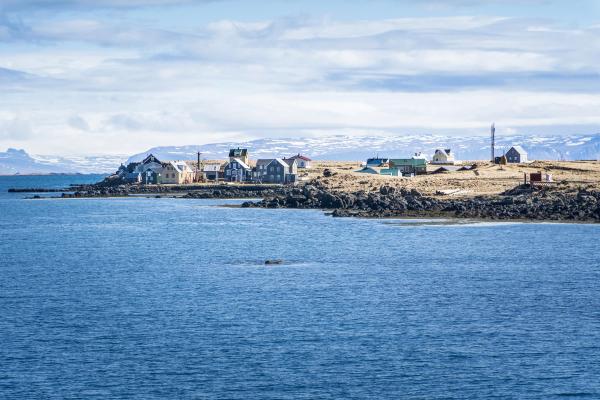
Dynjandi Waterfall
Known as the “Jewel of the Westfjords,” Dynjandi is one of the most spectacular waterfalls in the whole country. It’s a multi-tiered cascade with a total drop of 100 meters (330 feet). It’s nicknamed “the bride’s veil”, as it might look like that from some distance. There’s a trail from a parking area that allows you to get close to the waterfall.
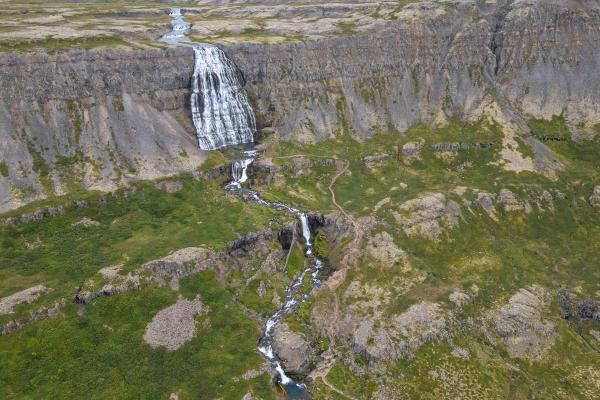
Ísafjörður
The Westfjords’ largest town, with 2,600 residents, Ísafjörður is a cultural hub 210 kilometers (130 miles) from Látrabjarg. Explore its historic buildings, visit the Westfjords Heritage Museum, or take the opportunity to taste some local food in one of its restaurants. It’s an excellent base for ferry trips to Hornstrandir or day trips to nearby fjords.
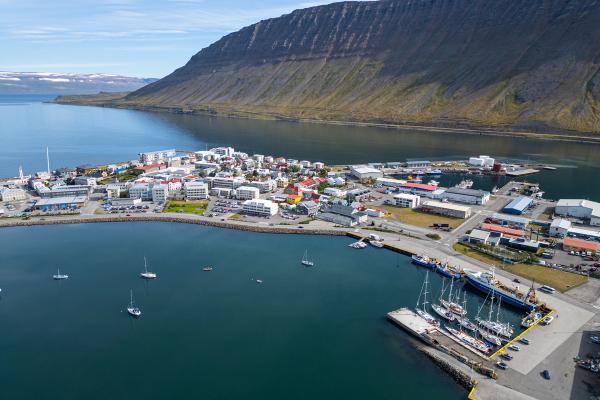
Where to Stay Near Látrabjarg
Accommodations near Látrabjarg are limited due to its remote location, but here are some options in the region:
- Fosshotel Westfjords (Patreksfjörður): It’s a modern hotel located 60 kilometers (37 miles) from Látrabjarg. It has comfortable rooms, a restaurant, and fjord views.
- Hotel Breiðavík: This the closest you can sleep from Látrabjarg, just 12 kilometers (7.5 miles) away. It’s a cozy hotel and camping site near a beautiful beach.
- Bjarkarholt: Located by Route 62, one of the roads leading to Látrabjarg, this family-run guesthouse provides cozy rooms and home-cooked breakfasts.
Travel Tips
- Respect Wildlife: Keep a safe distance from puffins and other birds to avoid disturbing the animals and their nests.
- Stay Safe: Don’t get too close to the cliff’s edges. There are no rails or fences, and the ground can be unstable in some places. Follow the painted lines marking the safe zones.
- Plan for No Services: Bring food, water, and warm clothes, as there are no shops or cafes at Látrabjarg. The nearest services are in Patreksfjörður.
- Check Road Conditions: In the summer, roads are typically open and in good condition. However, the rest of the year can make it a bit harder to get there. Winter can be impossible, but spring or autumn can present their challenges, too.
- Time Your Visit: Come at sunset to see the birds at their most active moment and with fewer visitors. It’s also the best time for photography.
- Book Ferries Early: If you want to go to Flatey or Hornstrandir, reserve ferry tickets with time in advance.

Conclusion
There are places that are difficult to describe unless you see them. Látrabjarg is one of those places. It’s a journey to the edge of Europe, where tall cliffs stand above the endless ocean and seabirds fill the air with their cries and colorful feathers. It’s a remote corner of the country and it’s not precisely easy to get there, but once you do, you won’t regret it.


